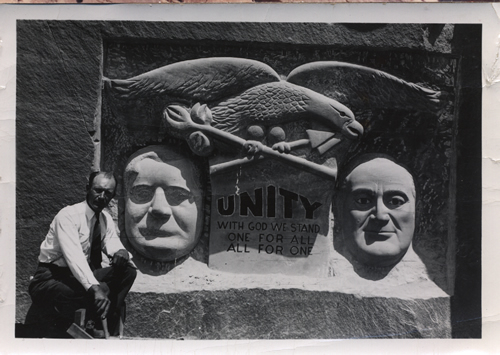 |
||||||
|
|
Albert Christensen loved stone, Jesus and Franklin Roosevelt. He was an artist from the time of his birth and was driven by an almost primal need to express himself. He created his own kingdom at "Hole n’ the Rock, a few miles south of Moab and filled it with his inspirations. A tour of Christensen’s famous home today is an exploration of his art and his passions; his many renderings of Franklin Roosevelt are everywhere, in oils and acrylics and watercolor, but it almost seems as if Albert was searching for a grander way to express himself. That he felt he just hadn’t got it right yet. The medium he needed, he would soon discover, was all around him. In the summer of 1940, all of Europe was at war. The Nazi Blitzkrieg had overwhelmed France and most of western Europe by June. The swastika of Hitler’s Third Reich flew over the capitols of Belgium, Holland, Norway and Sweden. Now Britain’s Royal Air Force fought a desperate battle for the skies above the English Channel with Goerring’s Luftwaffe. Prime Minister Churchill turned to the United States and President Roosevelt for help. Roosevelt knew England’s survival hung in the balance and was determined to do all he could to save. But FDR faced a crisis of his own at home. His second term as president was fast coming to a close and no president had ever run for a third. There was nothing in the Constitution to prevent it, but it was a tradition with roots as far back as Washington, who strongly believed eight years were long enough for one man to serve. Roosevelt was inclined to agree. "All that is in me longs to return to my home on the Hudson, " FDR lamented. But a growing isolationist movement across America worried the president. Roosevelt was convinced that a Republican presidential victory would not only spell disaster for Great Britain, but ultimately catastrophe for the United States as well. Roosevelt broke with tradition and tossed his hat into the Third Term ring. At the Republican convention in Philadelphia, Governor Tom Dewey and Senator Robert Taft battled fiercely for the nomination. But on the sixth ballot, the delegates abandoned the favorites and turned to the dark horse candidate, Wendell L. Willkie. Willkie wasn’t much of a back room politician; he wasn’t, in fact, much of a politician at all. Until recently, he been a registered Democrat. Throughout the campaign, the Republicans waged a bitter campaign against FDR, but Willkie preferred the high road and often distanced himself from the rhetoric that came from his own party. On election night, Roosevelt prevailed, though by a much smaller margin than his 1936 landslide and Willkie, gracious as always, conceded, FDR "is still the champ." After the election, and with a new mandate from the people, FDR pursued new ways to assist the besieged Britains. On December 16, 1940, he introduced legislation to the Congress—HB 1776. Roosevelt called it Lend Lease. In exchange for armaments, Britain would give the U.S. long term leases on British-held islands in the Atlantic. The bill was controversial and faced stiff opposition in the Congress, but Willkie testified in its behalf. "It is the history of democracy," he said, "that under dire circumstances, extraordinary powers must be granted to the elected executive." Willkie’s support insured Lend Lease’s passage. Later, FDR sent him to England to analyze the benefits. None of this was lost on Albert Christensen. Two thousand miles away, in the remote red rock deserts of southeast Utah, he took note of both men’s patriotism and honor. His devotion to FDR was already well known; now he wanted to honor Willkie as well. Later he would write, "The more I thought of this hard fought battle by these two Great Politicians, the more of a great story it became and the more eager I became to make this Concrete History for posterity’s sake. Why? Because, had anything such as this taken place in any other country other than the United States, I am convinced that one of these men would have been assassinated, or perhaps both of them. And that, to me, expresses our American Unity. An Expression of our Unity by two great leaders should have been brought to the attention of our youth..." The notion that FDR’s adversary would rally to the side of the man who defeated him touched Christensen deeply. And so he determined to pay tribute to FDR and Willkie in a way he deemed worthy. Albert turned to the magnificent sandstone cliffs that surrounded him. In the April 17, 1941 edition of the Times-Independent, a front page story carried the details of Christensen’s project. The Unity Monument, located just off the oiled highway a mile south of Cane Springs on the Moab-Monticello highway, is under construction and will be completed this year...Albert Christensen is the sculptor and the sculpture is being prosecuted under the direction of Ben H. Jackson.
The monument itself consists of the busts of President Franklin Roosevelt and Wendell Willkie, surrounded by the American Eagle. The following inscription also appears: UNITY With God We Stand All For One One For All The monument is being erected, according to the sponsors, in honor of these two leaders of America for the example they are setting for our people in the way of unity and preservation of American rights and liberties. Those behind the project feel that it is right and fitting that the American people should show appreciation to the two great political leaders while they are alive for the effort they are making to safeguard American democracy. The work of the monument is being carried on by popular subscription and the ground upon which it rests has been turned over to the Department of Interior for maintenance upon its completion. Christensen’s plans were "monumental," to be sure. The final version, what Albert himself called "colossal," was to be built on a massive sandstone wall in an alcove about a mile north of Hole n’ the Rock. According to the Times-Independent story, it would be "located so that 100,000 people could easily gather in a natural amphitheater below and in front of it." He set out to remove thousands of tons of rock and debris from the cliff face where the Unity Monument’s Colossal would be carved. The project, when finished, would feature 15 foot wide likenesses of Roosevelt and Willkie. The eagle would embrace both of them and measure 45 feet from wingtip to wingtip. Near the site of the final carving, Christensen went to work on a 1:6 scale model. By May it was almost complete. Christensen’s enthusiasm was contagious. Soon Moabites were making the 15 mile drive to the site to check Albert’s progress. And in late April, a group of Moab’s most prominent citizens invited Willkie to attend dedication ceremonies at the Unity Monument, tentatively scheduled for May 24, 1941. In part they wrote, "We wonder if it would be possible for you to be present and speak to this great western group of people who will be gathered in this vast natural amphitheater at the base of the monument. "It will be an opportunity for the advancement of ideas of true patriotism, genuine unity of democratic peoples, whether American or British, and the holding of the torch of liberty and the principles for which this country has stood and defended in both peace and war. "We covet for you this great single opportunity to present these cherished standards." The letter was signed by 18 Moab citizens, including Mayor D.E. Baldwin, Bish Taylor, publisher of the T-I, Sheriff J.B. Skewes, and LDS bishop W.R. McConkie. However, there is no evidence that Willkie ever replied. And then, Albert Christensen’s dreams were blown to bits. On August 28, 1941, just four months after Christensen’s plan was revealed, another Times-Independent article chronicled its startling and sudden demise. The headline, "Unity Monument Passes Into History," hardly prepared the reader for the bizarre story that followed... The Unity Monument near Cane Springs...has been ‘obliterated.’ N.F. Waddell, special agent in charge of the U.S. Division of Investigations, reported last week in Salt Lake City. Mr. Waddell, who explained that the Department of Interior had done the obliterating, commented that ‘some of the work was wrong.’ ‘I believe the eagle was facing the wrong way,’ he remarked. The special agent said the monument, destroyed several weeks ago, had already been damaged by someone before the Department of Interior stepped in. The monument, intended as a gift to the U.S. Department of Grazing, reportedly had the sponsorship of the Department of Interior earlier this year. In explaining the ‘obliteration,’ Mr. Waddell remarked that his department ‘has certain rules. We don’t give out much information.’ With that strange account, the Unity Monument disappeared from the pages of the Times-Independent. But Albert Christensen would not forget. Recently disc I must make clear the things which meant so much to me, the terrible thing which happened to my work before my very range of vision... The ‘Unity Monument’ was not just some chisel marks on the ledge. Indeed it was not. ‘Unity Monument’ spoke out louder and more clearly than the words any great elocutionist could have ever uttered, except Franklin D. Roosevelt, and he was in my opinion, the greatest. However, he was one of the Great Faces that I was cutting in relief...Why did I begin this work? And why was it so great? And why would our posterity be guided by inspirations given them though the observing of this Sacred work. The work of a master, educated and forever guided by the greatest educators, professors. Yes the criterion of human excellence. Later, Christensen tried to organize his thoughts more succinctly for what appears to be a demand for compensation from the federal government. In a typed document, but addressed to no one in particular, Christensen grappled with the reasons his sculpture had been destroyed. "To me," he complained, "it was one of the greatest expressions (of unity) because it showed no greediness. It showed only each man’s desire to win, and Americans are that way. Were they out for revenge after the election? I cannot think so." Finally, Albert pleaded, "That my friends and supporters of the Obliterated UNITY MONUMENT, our then Secretary of the Interior Department Shall Never Never be understood by the poverty-stricken Sculptor. I worked with a God Inspired ambition–quite unfair to my family, barely food enough to hold our bodies together–two minor children my wife and myself–because of a God. And a God Inspired obsession....If I had been in error in my filing, it seems the general land office would have tried to explain where I was in error and perhaps attempt to help me straighten the thing out, but they did not." According to the typed note, Christensen filed a $50,000 claim against the U.S. government, "for the cruelfull act by the Department of the Interior...I pray this allowance for damages from the United States Congress." There is nothing to suggest he ever received a reply. Some believe that the obliteration of the Unity Monument marked the beginning of an animosity between the federal government and longtime residents of rural Utah that exists to this day. But there is no record of any formal protest by southern Utah residents, other than Albert’s demand for compensation and Albert never attempted to revive the Unity Monument plan. He did, however, create a lasting tribute to one of his heros. On the sandstone cliff adjacent to Hole n’ the Rock, Albert carved a likeness of FDR that remains to this day. And up the canyon from Albert’s home, the obliterated Unity Monument can still be found. Two nubbins of rock are all that remain of the likenesses. But if you look very closely, Wendell Willkie’s right ear has somehow survived the government vandal’s chisel and the passage of time. One thing is certain: Willkie, Roosevelt and Albert Christensen deserved better. |
|||||







